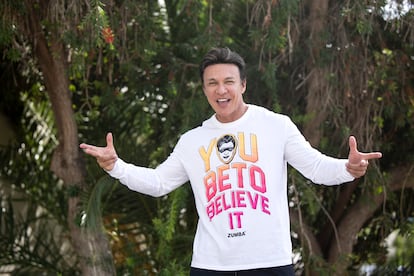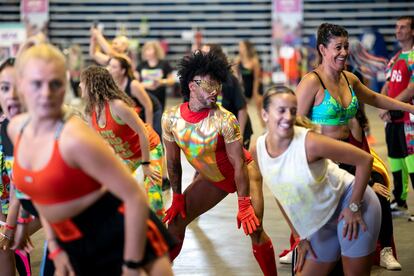Beto Pérez, the creator of Zumba: ‘I always dreamed of traveling and dancing with many people, but I never thought I’d be famous or a millionaire’
‘I was a visionary without knowing it,’ says the Colombian who invented this exercise by chance in the 1980s. Today, he owns a company worth millions of dollars, with businesses that include lines of clothing and cosmetics

When he was 16, Beto Pérez, now 53, began teaching aerobics classes in Cali, Colombia, in the late 1980s. In the 1990s, at age 20, he moved to the capital, Bogotá, to continue growing in the field. Then he traveled three times. Without papers and not knowing any English, he went to Miami, Florida, to seek opportunity. After having had to sleep on the street, the fourth time was the charm, and he finally got his chance. At the age of 29, he reached a turning point: he had to choose between an American businessman who offered to invest a million dollars in him and Alberto Perlman, his compatriot, who had almost nothing. “I chose [Perlman] because I felt best with him. And I think I made the right decision,” he says today. Pérez is the inventor of Zumba, an exercise that has made him and Perlman millionaires; everyone from Queen Letizia of Spain to Michelle Obama, Garbiñe Muguruza and Victoria Beckham has enjoyed Zumba. Over 15 million people do Zumba every week in 180 countries around the world. Pérez teaches at his own gym in Miami and holds occasional events around the world.
Last Saturday, over 500 people from all over Europe gathered at the Martín Carpena Sports Arena in Málaga to participate in a 10-hour Zumba class led by certified instructors. On the dance floor, the attendees — the overwhelming majority of whom were women — looked like the followers of a religion in which the uniform is made up of leggings, tops, and sweatshirts in garish neon colors, the hymns are merengue, reggaeton and samba, and the messiah is Beto Pérez himself. The wide-eyed participants laughed and moved their bodies, following the lead of the man who combined dance and aerobics in what came to be known as Zumba. Today, the Zumba company is worth over $500 million (almost €470 million). It has its own clothing brand — including collaborations with Hello Kitty and Crayola — and cosmetics line, among other businesses. “I always dreamed of traveling the world and dancing with many people, but I never thought I’d be famous, or a millionaire, or helping to change lives,” he acknowledges.
The father of Zumba describes the practice as “a series of movements disguised as dance that are really toning the body. It’s bringing a nightclub party to the world of fitness, without late nights and with water instead of alcohol,” he says. He is wearing a long-sleeved T-shirt that reads “You Beto believe it” with his own face drawn on it. On the Vix platform, one can watch a 70-episode series about his life, from his lonely childhood after his mother left to work in the United States to his successes and failures as an adult. On YouTube, one can easily find videos of Pérez giving group classes in places as varied as Rimini (Italy), Jakarta (Indonesia), Mexico City and Istanbul (Turkey). Soon, he will return to the United Kingdom and Japan. He chose Málaga as the destination for last weekend’s event because of its connections to Europe by plane, as well as for its beach and attractive prices. Over 500 participants were joined for a few minutes by tennis player Garbiñe Muguruza. Malena Costa, Shakira, Becky G and Claudia Leitte have also participated in events around the world. Zumba’s annual central convention is held in Orlando and attended by 8,000 people, all of whom are official instructors who have been trained and certified by Pérez’s company; after certification, they receive choreographies, music, and materials on a bimonthly basis to teach classes.

Following in Jane Fonda’s footsteps
Pérez himself has said on numerous occasions that in the beginning everything was the result of chance. As a teenager, he taught aerobics classes in Cali with music that he recorded directly from the radio on an old tape in the early hours of the morning (there were no commercials at that time of day). What music did he use? “Locomía, Rosario, El General, Juan Luis Guerra, those kinds of songs, whatever they played,” he says. That was the soundtrack for his classes. Then one day he forgot his cassettes. He had merengue, salsa, and other Latin rhythms on hand. To avoid admitting his mistake, he lied to his students, telling them that he had prepared something special for them. Then he improvised for an hour. And it worked well. “They loved it and asked for more; it was crazy. I was a visionary without knowing it,” he recalls.
That changed his life forever. First, it was done in Cali under the name Latin Aerobics, then in Bogotá as Rumba, and later in Miami, where he ended up working with Alberto Perlman — the son of one of Pérez’s students and now the CEO of Zumba Fitness LL — and Alberto Aghion; that was when Zumba was given its definitive name. “[We were] throwing out names like tinga, punga, panga, dumba… until we got Zumba, which has the Z for Zorro that I liked so much when I was a child.” Initially, the goal was to record some classes and sell them on DVD to help people in North America — which has high rates of obesity — lose weight. “That was how it was marketed, although my focus was more on joy, enjoyment,” says Pérez. When they launched the recorded workouts, they started receiving messages from people who wanted to train as instructors, so the company started a training program. They expected about 80 people but received 300 instead. It became a business, but because he could not handle all the classes himself, Pérez decided to delegate the task to trainer instructors.

So, what is it about Zumba that attracts such a wide audience? “People [can] exercise without feeling like they are doing exercise. Physical activity is associated with pain, sacrifice and stiffness, that happens here too, but what people remember is how much fun [they] had in class. This is a passion,” says Pérez. He emphasizes that there are no requirements for doing Zumba at the local gym: “Those who are totally arrhythmic will feel comfortable in the third class. And those who know how to move a little [will feel at home] from the first class. This is not an audition for Broadway, it’s just a way of expressing yourself and having a good time,” he explains. He adds that people of all ages practice Zumba: “All you need is your body.” To facilitate the participation of diverse groups, Zumba has developed new modalities: Zumba step, aqua Zumba, Zumba gold for seniors, Zumba sentao for abs, even Zumba for kids. “We have taken the trends, and we are reworking them so that the current generation can experience the great things that happened in the world of fitness in the 1980s and 1990s,″ explains Pérez, who idolizes Jane Fonda, the pioneer of aerobics.
The North American company signs agreements with famous artists for the rights to their songs, and they must request permission to use the word Zumba in their lyrics. In its beginning, Zumba was done to the beat of the Macarena and Aserejé; now it uses songs by Pitbull and Calle 13 and Luis Fonsi’s Despacito. “We buy the rights [to songs], because a good party needs quality music, but we also have Grammy winners who make songs exclusively for us,” says Pérez. He still enjoys teaching classes at City Zero, his exercise studio in Florida City, so he can stay close to his followers. “I don’t want to retire and walk away from reality,” he says.
Sign up for our weekly newsletter to get more English-language news coverage from EL PAÍS USA Edition
Tu suscripción se está usando en otro dispositivo
¿Quieres añadir otro usuario a tu suscripción?
Si continúas leyendo en este dispositivo, no se podrá leer en el otro.
FlechaTu suscripción se está usando en otro dispositivo y solo puedes acceder a EL PAÍS desde un dispositivo a la vez.
Si quieres compartir tu cuenta, cambia tu suscripción a la modalidad Premium, así podrás añadir otro usuario. Cada uno accederá con su propia cuenta de email, lo que os permitirá personalizar vuestra experiencia en EL PAÍS.
¿Tienes una suscripción de empresa? Accede aquí para contratar más cuentas.
En el caso de no saber quién está usando tu cuenta, te recomendamos cambiar tu contraseña aquí.
Si decides continuar compartiendo tu cuenta, este mensaje se mostrará en tu dispositivo y en el de la otra persona que está usando tu cuenta de forma indefinida, afectando a tu experiencia de lectura. Puedes consultar aquí los términos y condiciones de la suscripción digital.
More information
Archived In
Últimas noticias
Welcome to the post-religion era: The idea of Christianity as the absolute truth has become obsolete
‘I thought you would like it’: The risky sexual practice popularized by TV shows and TikTok
The digitalization of tourism: ‘They promise experiences and gave us the worst possible one’
Mexican peso defies uncertainty with forecasts of a new period of stability in 2026
Most viewed
- Sinaloa Cartel war is taking its toll on Los Chapitos
- Reinhard Genzel, Nobel laureate in physics: ‘One-minute videos will never give you the truth’
- Oona Chaplin: ‘I told James Cameron that I was living in a treehouse and starting a permaculture project with a friend’
- Why the price of coffee has skyrocketed: from Brazilian plantations to specialty coffee houses
- Silver prices are going crazy: This is what’s fueling the rally











































